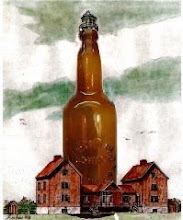These IPA brewers in the Northeast took much of their inspiration from the Burton brewing process, which meant that the beer was brewed with only pale malt, and was aged for an extended period in wood. Wood could be in the form of barrels, or large vats-which was the case with Fiegenspan and Ballantine. Hops were typically American Cluster, and Fuggles and whatever the brewers could get from Europe. Beer clarity was very important, I remember seeing old adverstisements for CH Evans IPA that claimed no sediment, no dregs.
Peter Egleston, John Thompson, and Dave Yarrington from Smuttynose Brewing Co. helped point me in several directions for my research into the Frank Jones Brewery of Portsmouth New Hampshire, one of the biggest IPA brewers back in the day, and recently Peter sent me this piece from the Greenway Brewing Co., which I found interesting:
I wasn’t familar with the Greenway Brewing Co. from Syracuse New York, but a quick internet search shows that the brewery was one of the biggest in New York State. Not sure if it was bigger than CH Evans of Albany in their prime. Some really interesting things about this sheet on their IPA:
 1. The abv is just a hair over 7% by volume (alcohol by weight x 5/4 = alcohol by volume). 7% was kind of the industry standard for IPA in the 1800s.
1. The abv is just a hair over 7% by volume (alcohol by weight x 5/4 = alcohol by volume). 7% was kind of the industry standard for IPA in the 1800s.
2. The final gravity, 1.015 is not that dry, a little sweeter than normal for the times. 1.015 Specific gravity equates to 3.75°P, which is about the upper limit of what I’d recommend in an IPA. Some of the English and Scottish versions from the same time period finished as dry as 1.0-1.5 °P.
3. The health claims are not unusual for the times either. In England, IPA was recommended frequently by physicians for those with stomach or sleep ailments. And one can see similar recommendations in the US.
When I was learning about pre-prohibition IPAs brewed in the United States, I focused most of my research on CH Evans from Albany NY, Frank Jones in Portsmouth, Fiegenspan and Ballantine in Newark. But it’s interesting that I was able to find IPA brewing references from many other breweries in that area, though I didn’t have time to research these other breweries as much as I would have liked to. Regarding the Frank Jones Brewery, the buildings of the old Frank Jones Brewery still stand in Portsmouth NH.



No comments:
Post a Comment